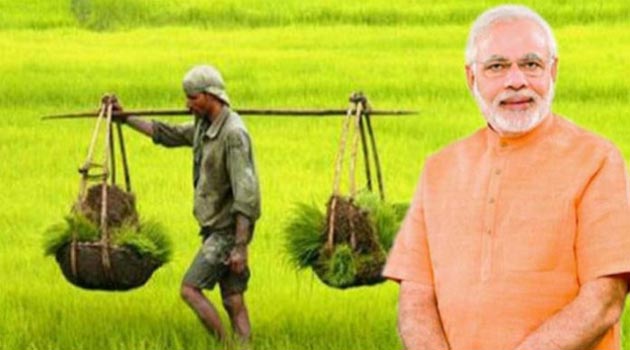Pradhan Mantri Fasal Bima Yojana
Pradhan Mantri Fasal Bima Yojana: A Major Farmer’s Friendly Initiative
Transforming Indian Farmer’s Destiny
Crop insurance
Crop insurance is purchased by the agricultural producers, including farmers, ranchers, and others to protect themselves against either the probability of loss of their crops due to natural disasters, such as hail, drought, and floods, or the expected loss of revenue due to declines in the prices of agricultural commodities unexpectedly, Thus Crop insurance was conceived as an instrument of risk management process in agriculture and as a measure to provide relief to innumerable Indian farmers whose crops were damaged by one or the other means.Need For Crop Insurance
Crop insurance is one alternative available to manage risk in yield loss by the farmers. It is a potent mechanism to reduce the overall impact of income loss on the farmer (family and farming). Thus, it is a means of protecting farmers against the probable variations in their yield, resulting from uncertainty of practically all natural factors beyond their control such as rainfall (drought or excess rainfall), flood, hails, other weather variables like (temperature, sunlight, wind), the pest infestation, etc. It is a financial tool to minimize the impact of loss in farm income by factoring in a large number of uncertainties occurring which affect the crop yields of the farmers. As such it is a risk management alternative process, where the production risk element is transferred to another party at a cost, which is called premium. To design and implement an appropriate insurance programme for the agriculture is therefore very complex process and a challenging task. There are two approaches to crop insurance, namely, the individual approach method, where yield loss on individual farms forms the basis for indemnity payment, and the homogeneous area approach method, where a homogeneous crop area is taken as a unit for assessment of yield and the payment of indemnity. Infact in both the cases the reliable and the dependable yield data for past 8-10 years are needed for the fixing premium on actuarially sound basis. India is a land of farmers where the maximum proportion of rural population depends on agriculture. Agriculture is the backbone of Indian economy. So the Govt. of India is dedicated to protect its farmer’s community’s interest always. This will not only help in sustaining the livelihood of our farmers, but also increase the yield of crops grown. But there are several natural hindrances which infact, prevent growth of crops. These are droughts, irregular rainfall, floods, etc. Further, these natural calamities result in the poor yield of crops and as the crops gets damaged in midway and production becomes less. Another concern is when there is an over production of the crops which happens sometimes. Then the market demand falls and thus the farmers do not get very good prices for their crops and they suffer great losses. This leads to greater economic losses for farmers and in some cases even, farmers have commit suicide. So to provide financial support to the farmers of this country, the Govt. of India has replaced the old crop insurance plan and it has drafted a new one this year, for the welfare of our farmers. A big initiative which will change the destiny of Indian farmers in the near future.Crop Insurance: An Overview
New Crop Insurance is no doubt a Mega Initiative, because despite of implementing several crop insurance schemes in India, farmers needs more protection from the govt. so that their farming risk can be insulated from various uncertain risk that they may encounter in their farming profession. The govt.has realized that the reason for thousands of farmers killing themselves every year is not just because of climatic factors; it is also due to the lack of protection from risks and helplessness, and the crop insurance, is not reaching them effecvtively, when they need it the most in their life. Pradhan Mantri Fasal Bima Yojana is a mega step in this direction, and will impact deeply the economic condition of the farmers of India. The fact is that , all the crop insurance models put in place so far since 1970s have met with only limited success and infact their effective implementation was lacking. In 1985, a crop insurance scheme in India called Comprehensive Crop Insurance scheme (CCIS) launched. In 1997, an Experimental Crop Scheme was launched which lasted only for a year. In 1999, National Agricultural Insurance Scheme (NAIS)launched to protect the farmers against losses suffered by them due to crop failures on account of natural calamities like; floods, drought, hailstorms, cyclone, pests and diseases etc. However, insurance was available for select crops “notified” crops only. This scheme was open to all farmers but was made compulsory for those farmers who had taken some kind of farm loans. The farmers had to pay flat insurance premium depending upon crop type and this premium was subsidized by government. There were several problems in NAIS model. Firstly, this scheme operated on a so called on the basis of “Area Approach” which means that the states would notify the unit areas of insurance such as blocks, mandals, Tehsil etc. The states would notify the areas on the basis of past yield data. Since yield data is crucial for crop insurance, success of this scheme was dependent on the availability of the data. The reliable data was not available with most states. Secondly, the states needed to notify the unit areas on the basis of part yield data and Crop Cutting Experiments (CCEs) every year well in advance. Most states did not follow these prerequisites. The result was that Insurance companies started crying foul because payable claims turned out to be several fold higher than the premium charged and subsidy paid. It was assumed that the states would share the premium subsidy but somehow most states were reluctant to do so., The NAIS was latter modified and was called Modified NAIS or M-NAIS. In this scheme, the area approach was done away with and the premium would be calculated on actuarial basis. This implies that the higher risk crops would have higher premium. The number of crops under the scheme was increased. Previously, only Agriculture Insurance Company (AIC) of India was allowed to implement the scheme but now, private insurers were also allowed to implement the modified scheme. Further, the unit area was reduced to be the Gram Panchayat. The MNAIS tried to modify several issues with the crop insurance but still failed to reduce the farmer distress. The key problems of this scheme was that – it covered risks partially, it had higher premium rates (3.5% for Kharif Crops and 1.5% for Rabi Crops), the coverage was capped (this implies that farmers could recover at best a fraction of the total loss). In 2007, another crop insurance scheme was launched Weather-based Crop Insurance Scheme (WBCIS). This was another scheme to protect farmers against vagaries of nature such as deficit and excess rainfall, high or low temperature, humidity, etc. This scheme was launched to settle claims in shortest possible time. Both these schemes (MNAIS and WBCIS) were made compulsory for loanee farmers. While former indemnified the cultivators against shortfall in crop yield; later protected against adverse weather conditions. Pradhan Mantri Fasal Bima Yojana Pradhan Mantri Fasal Bima Yojana (PMFBY) is the new crop damage insurance scheme that has been approved by the Union Cabinet in January 2016. It is one of the major initiatives and Farmers Friendly launched by the Present BJP government for the farmer’s welfare. A destiny changer for the farmers of India. It clearly indicates how our present government is seriously concerned for alleviating the problems of our farming communities in India and wants to provide every help to them always, who are the back bone of Indian Economy. New crop insurance scheme will bring about a major transformation in the lives of farmers. A great initiative to transform Indian farming life style. The Scheme is a Laudable measure taken by Govt., as it is focussing more on Crop Insurance which is the most vulnerable part of agriculture. The scheme is Inclusive and will surely help the farmers of our country at the time of distress. The new scheme is significant as the country is facing drought for the second straight year due to poor monsoon rains and the government desire to enhance insurance coverage to more crop area to protect farmers from vagaries of monsoon.How will the scheme benefits the farmers:
- With Low Premium rates and Total Coverage of Insurance of Crops, Farmers will benefit financially.
- Widening of the term Disaster(like Flooding of Crops and Damage after Harvest) ,will enlarge the Protection base and hence beneficial to farmers.
- Post Harvest Losses are also Included, So it will provide safety and confidence to the Farmers.
- Time Bound Payment of Losses will prevent delays and further worsening of Farmers’s distress condition.
- Will Reduce Farmers’ Suicide (Since Crop Failure and Financial Distress earlier was undressed but now ensured).
- Easy usage of technology like mobile phone, quick assessment of damage and disbursement within a timeframe.
Use of Technology
The scheme proposes mandatory use of the remote sensing technology, smart phones and drones for quick estimation of crop loss. Definitely this will speed up the claim process faster. Other features within next 2-3 years, the scheme aims to bring 50% farmers under the scheme domain. The settlement of claims will be fastened for the full sum assured. Further about 25% of the likely claim will be settled directly on farmers account. Further there will not be a cap on the premium and reduction of the sum insured. Comparison with earlier crop insurance schemes. The new scheme is different from earlier schemes on the account of following: It is open to all farmers but NOT mandatory to anyone. It is optional for loanee as well as non-loanee farmers. It has so far lowest premium. The existing premium rates vary in between 2.5% and 3.5% respectively for kharif crops and 1.5% for rabi crops respectively—but the coverage was capped, meaning farmers could, at best, recover a fraction of their farming losses. The farmers’ premium has been kept at a maximum of 2 per cent for food grains and up to 5 per cent for annual commercial horticulture crops. For rabi crops, it is 1.5%. The balance premium will be paid by the government to furnish full insured amount to the farmers. Since there is no upper cap on government given subsidy, even if the balance premium is about 90 percent, the government will bear it. This scheme provides full coverage of insurance. While NAIS had full coverage, it was capped in the modified-NAIS scheme. It also covers the localized risks such as hailstorm, landslide, inundation etc. Earlier schemes did not cover inundation. It provides post harvest coverage. The NAIS did not cover while the modified NAIS covered only coastal regions.Challenges in Implementation
Success of any government scheme largely depends on its sincere implementation effectively. The key problems issue such as poor land records, flawed land titles, and the major focus is corruption etc. are common challenges any crop insurance scheme in India faces. Further, the success of the scheme wholly depends on how sincerely it is implemented by the insurance companies throughout India. Further, we need to wait and watch as to how the scheme is monitored and supervised.Conclusion
New crop insurance scheme will bring about a major transformation in the lives of our farmers. A great initiative to transform Indian farming life style. The Scheme is a Laudable measure taken by Govt., as it is focussing more on the Crop Insurance which is the most vulnerable part of our agriculture. The scheme is Inclusive and will surely help the farmers of our country at the time of distress. The new scheme is significant as the country is facing drought for the second straight year due to the poor monsoon rains and the government wants to enhance insurance coverage to more crop area to protect farmers from vagaries of monsoon. Thus, new crop insurance scheme has the biggest potential to deal with the vagaries of nature on Indian farming. The premium to be paid by the farmers is kept very low when compared with earlier crop insurance schemes. Finally we can say that it is going to prove as a destiny changer for our farmers.References: Newspapers, Magazine and Websites
Author
Dr.Ashish Barua, Economist
B.A, BEd., LLB.,MA (Economics), MBA (Finance) PhD, (Economics) D.LItt (Economics),
Former: Director & Placement Advisor, Indian Institute Of Rural Management,
Former Co-Chairman, Centre For Banking & Financial Institution,NLU




Leave a Reply